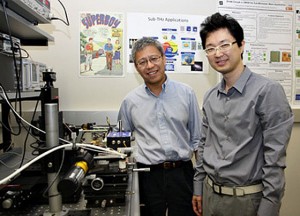
Researchers at UT Dallas have designed a new imaging chip that in the future could let mobile devices see through walls, wood, plastics, paper and other objects. The research team have linked two existing scientific breakthroughs into one. The first involves looking at the terahertz range, a previously unused range in the electromagnetic spectrum. The second utilize advancements in new microchip technology.
Infrared wavelengths have been used for years, making night vision devices among other things possible. The terahertz band, one of the wavelength ranges that falls between microwave and infrared, has however up till now not been accessible for most consumer devices.
“We’ve created approaches that open a previously untapped portion of the electromagnetic spectrum for consumer use and life-saving medical applications”, said Dr. Kenneth O, professor of electrical engineering at UT Dallas and director of the Texas Analog Center of Excellence(TxACE). “The terahertz range is full of unlimited potential that could benefit us all.”
The research team have devised sensors that can take images with signals created using the terahertz range without having to use lenses inside the device. Advancements in Complementary Metal-Oxide Semiconductor (CMOS) technology, that form the basis of many consumer electronic devices today, also allows image capturing devices to be smaller then before. This made CMOS technology an ideal and affordable solution for creating the a new chip to look closer at the terahertz range

“CMOS is affordable and can be used to make lots of chips”, Dr. O said. “The combination of CMOS and terahertz means you could put this chip and receiver on the back of a cellphone, turning it into a device carried in your pocket that can see through objects.” Due to privacy concerns, Dr. O and his team are focused on uses in the distance range of less than four inches.
In the near future it would not surprise me if I hear about technologies that claims to block the terahertz range, or maybe even companies creating new “lead filled” bathroom tiling to make money of peoples fear towards this type of technology. If you thought spy cameras in bathrooms, and the new “naked scanners” at some airports where creepy, this new research can potentially take creepiness to a whole new level all together.
On the positive side of things, the terahertz band and the technology now being developed may also make it possible for imaging solutions to detect cancer tumors, diagnosing disease through breath analysis, and monitoring air toxicity. “There are all kinds of things you could be able to do that we just haven’t yet thought about”, said Dr. O, holder of the Texas Instruments Distinguished Chair.
The research was presented at the most recent International Solid-State Circuits Conference (ISSCC). The team will continue their research towards building an entire working imaging system based on the CMOS terahertz system.
The work was supported by the Center for Circuit & System Solutions (C2S2 Center) and conducted in the TxACE laboratory at UT Dallas, which is funded by the Semiconductor Research Corporation (SRC), the state through its Texas Emerging Technology Fund, Texas Instruments Inc., The UT System and UT Dallas.
